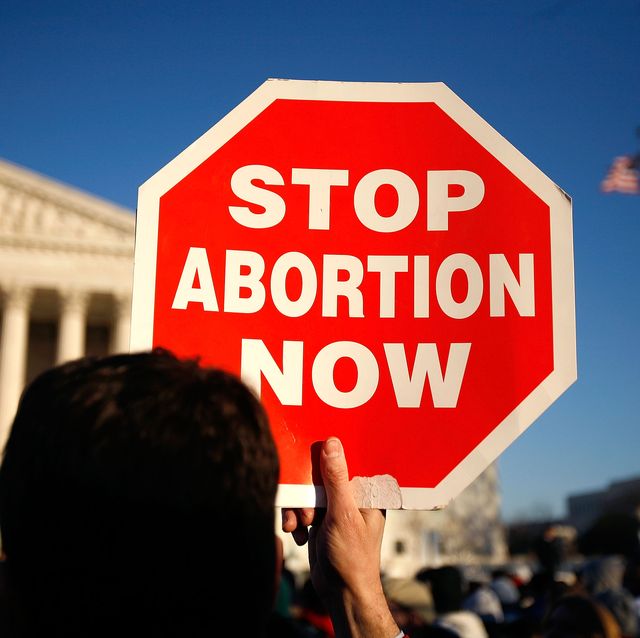“Late-term abortion.” By now you have probably heard the phrase everywhere. In their third and final debate, Donald Trump and Hillary Clinton fought over whether “late-term, partial birth” abortions, in the words of moderator Chris Wallace, should be legal in the United States. Media outlets publish the phrase regardless of whether the publication leans to the right or to the left. (Cosmopolitan has used it in the past too.) And while advocacy groups who oppose abortion use the term nonstop, well, even those that support abortion rights use it occasionally, too.
But in reality, no one should be using it. There is no specific medical definition for a “late-term abortion,” and because of that, abortion opponents are using it to mean anything they want.
“Even medical professionals commonly misuse abortion terminology,” Dr. David Grimes, author of Every Third Woman in America, How Legal Abortion Transformed Our Nation, wrote for the Huffington Post in 2014. Grimes, who provided abortions professionally for decades and even before the Roe v. Wade decision, may not be considered the most unbiased of sources, but the American College of Obstetricians and Gynecologists (ACOG)– the country’s largest professional group for those who provide medical care to pregnant people – agree.
"Though many media reports and other literature use the phrase ‘late-term abortion,’ it is not accurate and should not be used,” Hal Lawrence, M.D., executive vice president and CEO of ACOG, said in an email. “A full-term pregnancy is defined as a pregnancy with a gestational age between 39 weeks and 40 weeks, 6 days. ‘Late term’ refers to a pregnancy with a gestational age of 41 weeks to 41 weeks, 6 days. Abortions are not performed at ‘late term.’”
He added, "Because different methods of inducing abortion are effective at different stages of pregnancy, abortions are sometimes categorized by whether they occur in the first or second trimester. Clinicians sometimes use the term ‘early abortion’ to refer to abortions that occur up to 70 days gestational age, when medication abortion using mifepristone and misoprostol are highly effective. The term ‘later abortion’ is sometimes used to describe abortions that occur after 12 weeks gestational age. Describing these abortions as ‘late-term’ is simply inaccurate."
The problem is that this medically inaccurate terminology has already become ingrained in the rhetoric of how people talk about abortions, and for many abortion opponents, it is a phrase that they have been using almost as long as abortion itself has been legal. According to Johanna Schoen, associate professor of history at Rutgers University and author of the book Abortion After Roe, “late-term abortion” has been used by anti-abortion activists even as early as the mid- or late-1980s as a way of describing any abortion after the first trimester, but it didn’t work its way into mainstream use until the early 1990s when the public began debating Intact Dilation and Extraction (Intact D&E;) or what would eventually be known as a “partial birth abortion” – a procedure involving dilating the pregnant patient’s cervix then delivering the fetus’s body, then collapsing the skull in order to remove it more easily from the birth canal. Like “late-term abortion,” the phrase “partial birth abortion” is an evocative, highly politically charged term that has no actual medical definition that applies.
According to Schoen, the use of the phrase “late-term abortion” is actually meant to group together any procedure after the first trimester and erase any distinction in developmental along the gestational period of the pregnancy. “It immediately makes the conceptual jump to the idea of a viable fetus, and implies that they are all viable at that point,” she said. “There is no longer a second trimester. Instead they hope to make the emotional jump to just a viable baby. If it’s not a first-trimester abortion, then it is a viable baby, and there is nothing in terms of development in between.”
When abortion opponents define “late-term abortion” themselves, their words sound very similar to Schoen’s. According to the report “The Reality of Late-Term Abortion Procedures” published by Charlotte Lozier Institute, an anti-abortion research organization, “Late-term abortion is not an exact medical term, but it has been used at times to refer to surgical dilation & evacuation (dismemberment) abortions as well as intact dilation & extraction (partial-birth) abortions performed in the second (13-27 weeks) and third (27-39 weeks) trimesters.”
Public debate over abortion is already extremely challenging. But it’s even more challenging once it becomes clear that the terms being used have different meanings depending on the audience. It is impossible to have a meaningful dialogue if the public believes experts, activists, and politicians are discussing the moral issues of aborting fully developed baby just week or two away from an uncomplicated delivery and a long, healthy life, when abortion opponents are actually referring to a period in gestation where live delivery will at a minimum require months of hospitalization and potentially years of special medical care – in the very rare case that the baby survives at all.
The reality is simple when the language is used correctly: the House will soon vote on a ban on abortion at 22 weeks gestation (commonly known as the “20-week abortion ban”) – with no exception for fetal anomalies and a requirement that if a woman is raped, she must undergo mandatory counseling at least 48 hours before her procedure or have had a medical exam after the assault. It is a ban on abortion at the very cusp of viability, at a point when only a “tiny minority” of those who are born at that gestation and medically treated will survive without severe medical conditions, according to even the most recent and exhaustive of scientific study on extremely preterm babies.
It is a later abortion ban that would go into effect halfway through the second trimester, and one that would affect those who either receive a new and unfortunate diagnosis about the pregnancy, or who had too many hardships – either financially, logistically or both – to obtain a termination earlier.
But it is not a “late-term” abortion ban, and it is up to those who support abortion rights to explain that, and push back on anyone who uses that phrase – our friends and families, the media and politicians, and yes, even our own allies. Because if we continue to allow abortion opponents to mislead the public and erase the distinction between a developing fetus and a viable baby ready to be born, then we allow them to completely erase the physical and emotional needs of the pregnant person, as well as any ability for them to make the medical decisions that are best for them, their families and, yes, sometimes even the fetus itself.
Robin Marty is the co-author of Crow After Roe: How "Separate But Equal" Became the New Standard in Women's Health and How We Can Change That. Follow her on Twitter.












